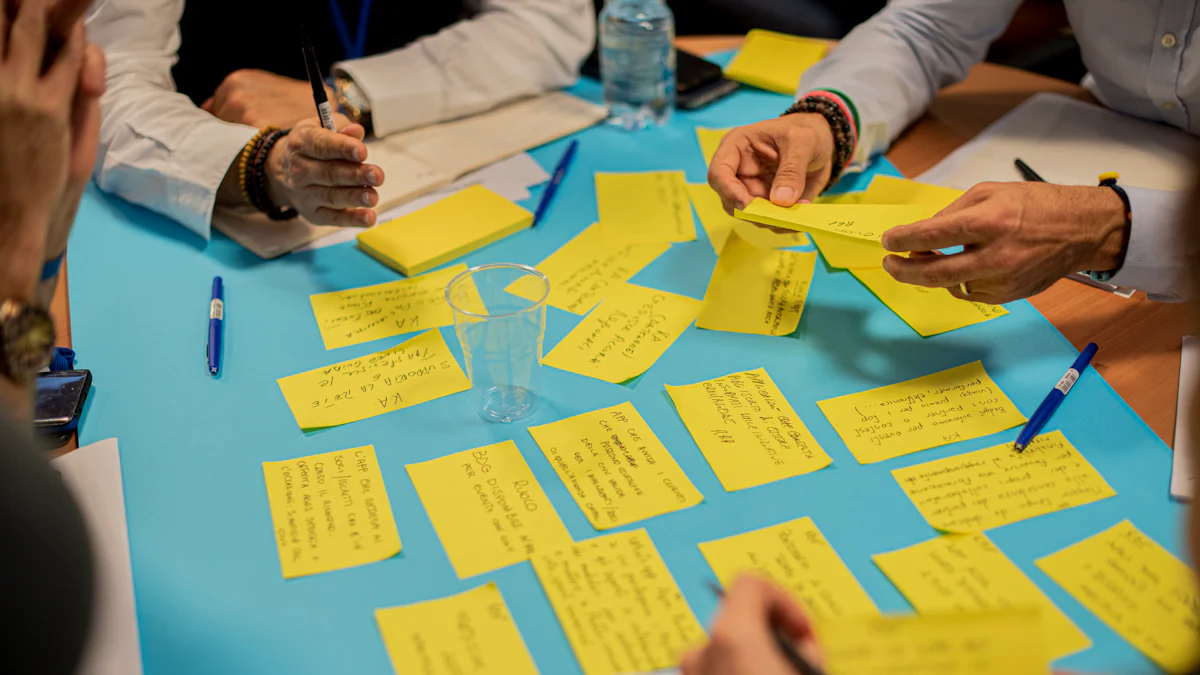10 Effective Strategies to Leverage GlobalGPT for Academic Writing

In the realm of academic writing, GlobalGPT emerges as a pivotal tool for scholars seeking to elevate their papers. Its integration offers a revolutionary approach to crafting well-structured and coherent content. By harnessing the power of AI tools like GlobalGPT, writers can transcend traditional limitations and unlock new levels of creativity and efficiency. This introduction sets the stage for exploring 10 Effective Strategies to Leverage GlobalGPT for Academic Paper Writing that will revolutionize academic paper writing.
Understanding GlobalGPT
When delving into the realm of GlobalGPT, one encounters a sophisticated AI tool designed to revolutionize academic writing. This section aims to elucidate the essence of GlobalGPT and delineate its distinctive features compared to other AI counterparts.
What is GlobalGPT?
Overview of its features
Enables seamless integration into academic writing processes
Facilitates efficient generation of well-structured content
Enhances the overall quality and coherence of papers
How it differs from other AI tools
Offers a more comprehensive approach to content creation
Provides tailored assistance specific to academic requirements
Ensures a higher degree of accuracy in generating academic content
Benefits of Using GlobalGPT in Academic Writing
Efficiency and time-saving
Streamlines the writing process by offering prompt suggestions and insights
Reduces the time spent on brainstorming, drafting, and editing tasks
Enhances productivity by providing quick solutions to common writing challenges
Enhanced quality of writing
Elevates the standard of academic papers through refined language usage
Improves clarity and coherence in presenting complex ideas
Helps maintain a consistent tone and style throughout the paper
Strategy 1: Topic Generation

When initiating the process of Topic Generation using GlobalGPT, writers can unlock a plethora of innovative ideas and concepts. By employing this strategy effectively, scholars can enhance their brainstorming sessions and foster creativity in their academic pursuits.
Using GlobalGPT to Brainstorm Ideas
Techniques for effective brainstorming
Utilize GlobalGPT to explore diverse perspectives on a given topic
Incorporate keywords related to the research area to generate targeted suggestions
Experiment with different prompts to stimulate unique thought processes
Examples of generated topics
Exploring the Impact of Technology on Education in Developing Countries
Analyzing the Role of Artificial Intelligence in Healthcare Systems
Investigating Sustainable Practices in Urban Planning
Strategy 2: Research Assistance
When engaging in Research Assistance with GlobalGPT, scholars can significantly enhance their literature review processes. By leveraging the capabilities of this AI tool, researchers can efficiently locate pertinent sources and succinctly summarize essential points.
Leveraging GlobalGPT for Literature Review
Finding relevant sources
Utilize GlobalGPT to identify scholarly articles and academic papers related to the research topic.
Input specific keywords into the system to prompt targeted suggestions for credible sources.
Explore a variety of databases and online repositories with the assistance of GlobalGPT.
Summarizing key points
Extract core ideas and arguments from identified sources using GlobalGPT.
Condense lengthy passages into concise summaries while maintaining the original meaning.
Create an organized overview of key findings to support the literature review's coherence.
Strategy 3: Structuring Your Paper
Outlining with GlobalGPT
When Structuring Your Paper utilizing GlobalGPT, writers embark on a journey towards creating a well-organized and coherent academic document. This section focuses on the significance of outlining with GlobalGPT to ensure the logical progression of ideas and comprehensive coverage of topics.
Creating a logical flow
Begin by defining the primary objective of your paper to establish a clear direction for the content.
Utilize GlobalGPT to outline the main sections and subtopics, ensuring a smooth transition between ideas.
Arrange the information in a sequential manner to guide readers through a logical progression of arguments.
Ensuring comprehensive coverage of topics
Identify key themes and concepts that need to be addressed within your paper using GlobalGPT.
Expand on each topic by incorporating relevant details and supporting evidence to enhance the depth of discussion.
Review the outlined structure to verify that all essential points are included, providing a holistic view of the subject matter.
Strategy 4: Writing Assistance

Drafting with GlobalGPT
When Drafting with GlobalGPT, writers embark on a journey towards creating compelling content for different sections of their academic papers. By utilizing this strategy effectively, scholars can ensure the maintenance of an academic tone and style throughout their writing.
Generating content for different sections
Initiate the drafting process by inputting key points and ideas into GlobalGPT to generate detailed content for each section.
Utilize the AI tool to expand on arguments and provide in-depth analysis within the introduction, body paragraphs, and conclusion.
Ensure a seamless transition between sections by incorporating transitional phrases suggested by GlobalGPT.
Maintaining academic tone and style
Employ formal language and terminology relevant to the academic field to uphold the scholarly nature of the paper.
Verify that the vocabulary used aligns with the subject matter and maintains consistency in tone throughout all sections.
Refine sentence structures and phrasing based on feedback from GlobalGPT to enhance readability and coherence.
Strategy 5: Editing and Proofreading
Using GlobalGPT for Grammar and Style Checks
When Utilizing GlobalGPT for Grammar and Style Checks, writers can ensure the refinement of their academic papers to meet scholarly standards. The AI tool aids in Identifying common errors and Enhancing readability and coherence throughout the document.
Identifying common errors
Employing GlobalGPT assists in pinpointing grammatical inaccuracies within the text.
The tool highlights areas that require correction, such as punctuation mistakes or improper verb usage.
By utilizing this feature, writers can enhance the overall clarity and precision of their writing.
Enhancing readability and coherence
GlobalGPT offers suggestions to improve sentence structures for better flow and comprehension.
It provides insights on enhancing the coherence between paragraphs to maintain a logical progression of ideas.
Writers can rely on this functionality to refine their writing style, ensuring a polished final draft.
Strategy 6: Citation and Referencing
Automating citations with GlobalGPT streamlines the referencing process, ensuring accuracy and consistency in academic papers. By leveraging this feature, writers can effortlessly manage their reference list and adhere to proper citation formats.
Automating Citations with GlobalGPT
Ensuring proper citation formats
GlobalGPT meticulously formats citations according to the specified style guide, whether APA, MLA, or Chicago.
The tool ensures that all elements of a citation, including authors' names, publication dates, and titles, are correctly structured.
By automating this process, writers can avoid manual errors and maintain scholarly integrity in their work.
Managing references efficiently
GlobalGPT organizes references alphabetically or numerically based on the chosen citation style.
It updates citations automatically when new sources are added or removed from the paper.
Writers can easily export the formatted reference list for inclusion at the end of their academic document.
Strategy 7: Plagiarism Check
In the realm of academic writing, ensuring originality is paramount to GlobalGPT users. By leveraging the Plagiarism Check feature, writers can maintain the integrity of their work and uphold ethical standards within scholarly communities.
Ensuring Originality with GlobalGPT
Detecting potential plagiarism
Scholars utilizing GlobalGPT for academic writing can rely on its advanced algorithms to detect any instances of potential plagiarism. The tool meticulously scans through the content, comparing it to a vast database of existing works to identify similarities or direct matches. This proactive approach enables writers to address any unintentional replication and ensure the authenticity of their research.
Paraphrasing and rephrasing techniques
To mitigate the risk of plagiarism, GlobalGPT offers sophisticated paraphrasing and rephrasing capabilities. Writers can utilize these tools to transform existing sentences or passages into unique formulations while retaining the original meaning. By incorporating varied sentence structures and synonyms suggested by GlobalGPT, scholars can effectively enhance the originality of their work without compromising on clarity or coherence.
Strategy 8: Collaborative Writing
In the collaborative realm of academic writing, GlobalGPT serves as a unifying force for group projects, harmonizing diverse contributions and writing styles seamlessly. By leveraging the collective intelligence facilitated by GlobalGPT, scholars can transcend individual limitations and co-create scholarly works that amalgamate varied perspectives into a cohesive narrative.
Using GlobalGPT for Group Projects
Coordinating contributions
Initiate the collaborative process by establishing clear objectives and delineating individual roles within the group.
Utilize GlobalGPT to synchronize ideas and ensure alignment in thematic development across different sections of the paper.
Implement a structured feedback mechanism to streamline communication and enhance collaboration efficiency.
Merging different writing styles
Embrace diversity in writing styles by leveraging GlobalGPT to harmonize varying tones and expressions.
Seamlessly integrate distinct voices into a coherent narrative that reflects the collective expertise of the group members.
Ensure consistency in formatting and language usage throughout the collaborative document to present a unified academic perspective.
Strategy 9: Enhancing Critical Thinking
Analyzing Arguments with GlobalGPT
To enhance critical thinking skills, scholars can delve into the realm of Analyzing Arguments with GlobalGPT. By leveraging this AI tool, researchers can elevate their ability to evaluate evidence and construct logical arguments effectively.
Evaluating evidence
GlobalGPT aids in scrutinizing evidence by providing insights into the credibility and relevance of supporting data.
Scholars can utilize the tool to assess the strength of arguments based on factual accuracy and logical reasoning.
By analyzing evidence through GlobalGPT, researchers can develop a more nuanced understanding of complex issues and viewpoints.
Constructing logical arguments
Utilize GlobalGPT to structure arguments cohesively, ensuring a clear progression from premises to conclusions.
The AI tool assists in organizing ideas logically, enhancing the persuasiveness and coherence of academic discourse.
By employing GlobalGPT for argument construction, scholars can refine their critical thinking skills and present compelling narratives that resonate with readers.
Strategy 10: Continuous Improvement
Upon delving into the realm of Continuous Improvement with GlobalGPT, scholars embark on a journey of refinement and growth in their academic writing endeavors. By embracing the feedback provided by this AI tool, writers can identify areas for enhancement and implement valuable insights to elevate their future writing projects.
Learning from GlobalGPT Feedback
Identifying areas for improvement
Reflect on the feedback generated by GlobalGPT to pinpoint potential enhancements in content structure and clarity.
Analyze suggestions related to language usage and coherence to streamline the overall flow of academic papers.
Identify recurring patterns in feedback to address fundamental aspects of writing that require attention.
Implementing feedback in future writing
Integrate constructive feedback from GlobalGPT into subsequent writing tasks to enhance the quality and depth of content.
Apply insights gained from AI-generated suggestions to refine argumentation and strengthen critical analysis within academic papers.
Continuously iterate on writing practices based on feedback received, fostering a culture of continuous improvement in scholarly endeavors.
Recapping the 10 Effective Strategies to Leverage GlobalGPT for Academic Paper Writing unveils a transformative approach to scholarly endeavors. The benefits of integrating GlobalGPT in academic writing are profound, enhancing efficiency and elevating the quality of papers. Encouraging the adoption of these strategies into daily writing routines fosters continuous improvement and innovation. As AI continues to shape academic landscapes, embracing tools like GlobalGPT promises a future where creativity and intelligence converge seamlessly.
